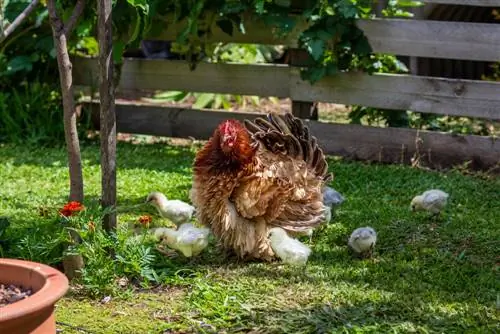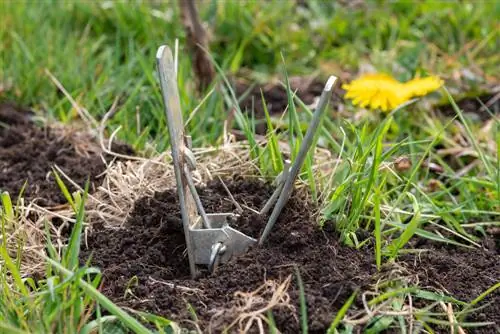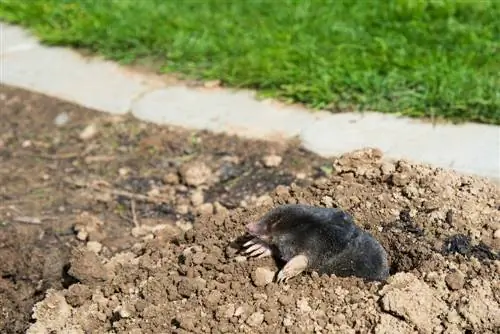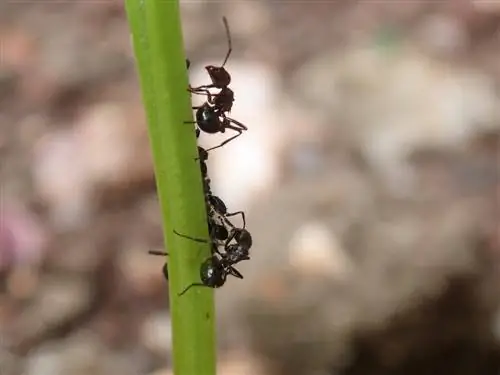- Author admin [email protected].
- Public 2023-12-16 16:46.
- Last modified 2025-06-01 06:02.
A natural garden doesn't mean that a cheeky marten can dance around on your nose. This guide is intended for hobby gardeners who ask themselves: What helps against martens in the garden? Read well-founded tips here on how to recognize the robber, successfully chase them away and effectively prevent them.

How can you successfully get rid of martens in the garden?
To get rid of martens in the garden, fragrances and bitter substances such as chili powder, camphor, vinegar or essential oils can be used. Toilet stones, human or cat hair and human urine can serve as home remedies. For professional help, contact a licensed hunter or certified exterminator.
- Martens generally do not dig holes in the garden or root around in beds.
- Nocturnal martens can be recognized in the garden by their droppings, an intense smell of excrement and scent marks.
- Capturing with a live trap is only permitted to licensed hunters and certified exterminators, because martens are creatures worthy of protection and are subject to hunting law in Germany.
Do martens dig holes in the garden?
Various miscreants cause small and large holes in the garden. Martens are not included. Mice, rats, earthworms and other underground garden inhabitants are on the stone marten's menu. Of course, the predator prefers to hunt on the surface at night. Martens are very shy and prefer to keep an eye on their surroundings, which is not guaranteed when digging holes in the ground. You only dig when you have to break into the chicken or rabbit coop.
When home gardeners struggle with holes in the garden, other culprits come into focus. Small holes are primarily dug by rabbits, rats and hedgehogs. The mole and vole build a mound of earth over the hole. Foxes and badgers are responsible for large hollows that act as dangerous tripping hazards.
How can you recognize martens in the garden?

Young martens in particular are actually quite cute, but they also cause a lot of damage
Beech martens are nocturnal, extremely shy, quick to react and agile. These characteristics make a direct encounter with a marten in the garden during the day a rare event. When hobby gardeners suspect the presence of a small predator in their green kingdom, various telltale signs come into focus. The following table lists important identifying features for the presence of a marten in contrast to cats, weasels and raccoons:
| Recognize in the garden | Marten | Cat | Weasel | Raccoon |
|---|---|---|---|---|
| Feces (size) | 1-2 cm thick, 8-10 cm long | 2 cm thick, 3-4 cm long | 0, 5-1 cm thick | short |
| Feces (form) | sausage-shaped, twisted tip | elongated, smooth | twisted, long tip | in heaps |
| Excrement smell | intense, unpleasant | strict | intense, unpleasant | stabbing |
| Sounds (seasonal) | hissing, screaming, rumbling | hiss, howl | barely audible | growling, squealing, whining, screaming |
| Fragrance brands | bad-smelling glandular secretion | mild, smelly when repeated | Marten-like smell | Musky |
The most difficult thing is to distinguish between martens and weasels. The animals are botanically related and have a similar lifestyle. The most important difference for garden, house and car owners is that weasels don't rumble around in attics and don't nibble on car cables.
Detecting marten excrement
Sharp eyes and a good nose are required if you want to track down a marten in the garden. Apart from the shape and size of the solution, the remains of the stone marten differ in recognizable cores, feathers and hair. The last doubts are dispelled by a foul smell emitted by marten droppings. In contrast, cats bury their excrement, so the smell is rarely noticeable. Raccoon droppings are said to have a not so strong musky scent.
Noises as a seasonal indicator
For most of the year, martens live solitary lives and do not make any noise. Only during the mating season do nighttime territorial fights in the garden cause turmoil. When male martens fight over the lady of their heart, they make similar fighting noises to those made by cats, but louder, more deafening and shriller. Thunderous rumbling in the garden house or barn reveals that a female is raising her offspring, which is always associated with a ruckus in the Marder family. There is a risk of confusion with raccoons, which boldly break into the house at night and plunder the pantry.
Fragrance brands
As territorial animals, martens are equipped with a gland that produces a secretion to mark territory. A marten marks its territory in the garden almost all year round with its intensely smelling secretion. Both males and females use this strategy, which is unpleasant for human noses. Cat scent marks only attack the human sense of smell when a repeat offender is at work. When weasels use scent to mark their territory, there is a faint, marten-like smell.
Are martens useful or harmful in the garden?

If you have chickens in your garden, you should be afraid of martens
Martens do not root around in the garden, do not dig holes, do not eat plants and only occasionally eat berries or fruits. On the contrary, omnivores primarily eat small mammals and rodents, such as mice, rats, frogs and moles. Insects, cockchafer larvae and earthworms are also not ignored. A number of pests fall victim to the marten, which the nature-loving gardener appreciates and welcomes the nocturnal hunter as a beneficial insect.
The other side of the coin is a big appetite for chickens, ducks and pigeons. Many people resent the marten for their love of poultry of all kinds and view the predator as a pest. Serious damage caused by martens in the garden can always be complained about when livestock is kept alongside the cultivation of plants.
Excursus
Make your car marten-proof
While martens are actually useful in the garden, the little predators cause millions of dollars in damage to vehicles every year. To prevent nocturnal predators from attacking your car, NABU (Nature Conservation Association) recommends placing a wooden frame with wire mesh under the parked vehicle. Tight-meshed wire mesh causes painful torment for small marten paws. Regular car and engine washing removes the scent marks that a marten uses to mark its territory and remember the route to the vehicle. Help against engine damage caused by a car marten is promised by a special deterrent spray (€13.00 on Amazon), which protects cables and hoses from being bitten for six to eight weeks and can then be refreshed.
Martens in the garden - what to do?
Martens are creatures worth protecting. The Federal Nature Conservation Act confirms what animal-friendly hobby gardeners have already been practicing for a long time. Chasing them away and keeping them away is permitted, damaging he alth or killing them is taboo. Various non-toxic options and home remedies are available to forcefully compliment the cheeky pests from the garden. This is what you have to do if you want to get rid of martens:
Fragrances and bitter substances
- Chili powder: scatter at excrement locations and renew regularly
- Camphor: Distribute leaves and whole shoots in the garden
- Vinegar: wet the garden soil with a spray bottle (avoid contact with plants)
- essential oils: Spray tea tree oil and similar scents or let them exude from open bowls
Home remedies
- Toilet stones or mothballs: lay out in the garden, on the terrace or balcony
- Human or cat hair: collect while combing and distribute to suspicious marten locations
- Urine: spraying human urine in the garden
There is no home remedy to offer a panacea against martens in the garden. The use can achieve short-term success, but is of course associated with various disadvantages. Above all, the cost factor should not be underestimated, because the duration of effectiveness is limited.
Manual methods

Live traps are a very humane way to catch martens
The local hunter promises effective help against martens in the garden. As an expert, he knows how to catch wild animals as gently as possible with a live trap. Furthermore, professional exterminators are permitted to capture martens and release them into the wild at a suitable location. Please note that there is a strict closed season that extends from March 1st to October 15th.
The water bottle method of chasing martens out of the garden or car is controversial. Since the product costs little and works without chemicals, it may be worth trying. Fill some PET bottles two-thirds full with water. Hang and place the water bottles in suspicious locations. It is not yet clear why martens run away from bottled water.
Tip
If you drive a marten out of the garden, the house should not offer the escapee any loopholes. The night owl makes itself unpopular as a poltergeist in the attic or basement. Close all openings with a diameter of 5 cm or more with wire mesh, plaster or concrete. Wrap tree trunks near the house with a marten repellent belt to block the climbers' way into the house.
Preventing martens in the garden - tips & tricks

The piss-off plant also keeps martens away
Martens are clever robbers, skilled climbers and can jump up to 2 meters high. If stone martens invade a garden, they make short work of ducks and chickens. It is advisable to secure the area from stone martens before the poultry move in. The following preventive measures offer protection from a marten in the garden:
- Fence the garden with a close-meshed wire fence up to a height of 250 cm and a depth of 80 cm
- Enclose the area with a mixed hedge of thorny barberry (Berberis julianae), holly (Illex), hawthorn (Crataegus) and dog rose (Rosa rugosa)
- Plant scare plants, like the legendary piss-off plant (Plectranthus ornatus)
- Bring farm animals into a burglar-proof stable every evening
Martens are not only shy, but also resentful. Place motion detectors with water sprayers in the garden. The device locates the robber and shoots a short, powerful jet of water in his direction. Your uninvited nighttime guest will not forget this horror and will avoid the area from now on.
Frequently asked questions
Are martens dangerous in the garden?
If a marten has chosen your garden as its new home, its presence poses no immediate danger to humans. In contrast to cats or raccoons, neither the animal nor its feces transmit dangerous diseases. However, the presence of the predator does not end well for chickens, ducks, rabbits and birds. If you can tell from evidence that a marten is in the garden, you should protect cages and enclosures and chase the intruder away. Trapping is only an option in winter under the direction of a hunter or certified exterminator.
We have a dead marten in our garden. What to do now?
If a marten dies in your garden, please contact the nearest rendering facility. Neither the public order office, the police nor hunters are responsible for abandoned, dead small animals. Instead of having the carcass picked up at your own expense, most municipalities allow it to be disposed of in the trash can.
Tip
Ultrasonic devices only achieve short-term success if you want to get rid of martens, mice and other uninvited guests in the garden. In practice it has been shown that the clever fur wearers wait at a safe distance for the noise to stop and then return. In the worst case, the animals become deaf as a result of the ultrasonic noises, which is a high price to pay for disturbing the peace at night.






